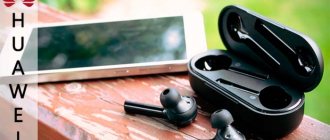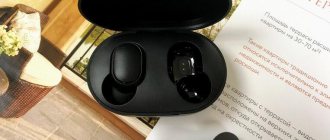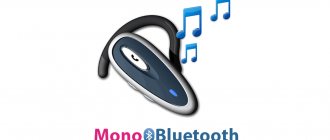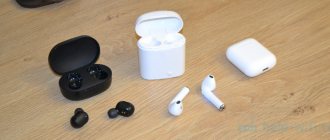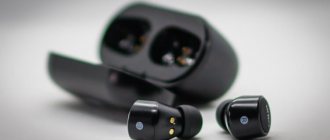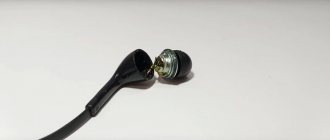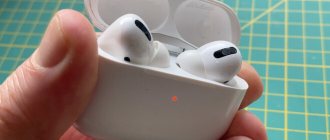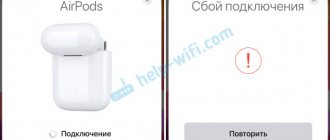This article is a detailed guide to troubleshooting various problems with all models of QCY wireless TWS Bluetooth headphones. In some articles and online stores you can see the name Xiaomi QCY. This is a sub-brand of Xiaomi. They make inexpensive and fairly high-quality TWS headphones, which are very popular. But like any equipment, an earphone from QCY can also break, stop working, etc. In this article I will talk about solving the most popular problems. When, for example, one earphone stops working and only the right or left plays. When the QCY headphones are not paired with each other, desync occurs, resulting in only one ear working. When the headphones are not connected to the phone, computer, etc., he does not see them. Let's look at different solutions to charging problems. And I’ll show you how to reset your QCY headphones.
I will try to make the most universal guide that is suitable for all models: QCY T1X, T2S, T2C, T4, T5, T7 TWS, T8, T8S T9S, T10, M10, T11, T12, T1C, M18, HT01 ANC TWS Bluetooth Earbuds, T6 TWS, T1 Pro, QS2, etc. There are a lot of models, but the principle of their operation and the algorithm for solving faults is not very different.
Tip: Most problems with QCY wireless headphones can be resolved by resetting the settings , resynchronizing and connecting to the device. If you do not want to understand all the nuances and problems, then immediately go to the section of the article where I show how to reset and complete it.
The most popular problems and solutions:
- The right or left earphone does not work. QCY headphones do not pair with each other and work separately. That is, the sound is reproduced only through one ear, right or left. This may happen after connecting the headphones. They simply switch to mono mode and one of the headphones stops working as a pair and the sound in it disappears. Solution: reset settings to factory defaults and synchronize (happens automatically).
- QCY headphones do not connect to your phone, tablet, laptop or other device. When the device does not see the headphones. Solution: disconnect headphones from other devices, turn them off/on, reset settings.
- One or both QCY headphones are not charging. The indicator on the earphone after installation in the case does not light up at all, or continues to light up in white or green. The earphone is discharged and does not turn on. Solution: check the contacts on the earphone and charging case. You can try to reset. Make one interesting solution: hold down the button on the earphone and put it in the case (I’ll tell you more about this in the article).
- The earphone stopped working, the indicator does not light up, and does not respond to anything. Solutions: eliminate problems with charging, put it in a case with the button pressed, do a Reset. Perhaps this is a hardware failure.
Why does only one QCY earphone work?
The headphones are out of sync. This is a very popular problem with all wireless TWS headphones. To work in pairs, one earphone is connected to the second, which in turn connects to the device. Due to a software or hardware glitch, when the headphones were not connected correctly, or when using only one earphone, they may become out of sync. If it's just a glitch, it can be easily resolved by resetting the settings.
But it happens that the right or left earphone is simply broken. That is, some kind of hardware failure, or problems with charging. In this case, it most likely will not work at all (the indicator will not light up). Here only repairs at the service center. Or try to eliminate problems with charging yourself (I will talk about this in more detail in the article).
A separate article with solutions to this problem: one wireless earphone does not work, it stopped playing.
Options
- Model: In2017
- Device name: QCY-T7
- Bluetooth Version: V5.1
- Charging time: approximately 2 hours
- Talk time: approximately 2 hours
- Operating time while listening to music: approximately 4 hours
- Standby time: approximately 60 hours
- Range: 10 meters without obstacles
- Battery type: Li-ion
- Battery capacity (earphone): 3.7v 35mAh
- Battery capacity (case): 3.7v 380mAh
- Case charging current parameters: 5v 400mA
- Bluetooth profiles: HFP/A2DP/AVRCP
Reset QCY headphones to factory settings
First of all, I will show you how to do a factory reset, as this very often solves all problems with desync, when only one earphone works, connection problems, etc.
We'll look at two different methods (if the first one doesn't work, try the second one). It all depends on the model and hardware version of the headphones. But in any case, if the headphones are already connected to some device (phone, computer), they need to be removed (forgotten).
This is very easy to do. Go to Bluetooth settings, find your headphones there and remove them. On Android devices and iPhones this is done almost the same way.
If the right and left headphones are connected separately, remove both. It is advisable to do this on all devices to which you connected headphones. You can try simply turning off Bluetooth on these devices.
Method 1: reset outside the case
- We take the headphones out of the case.
- At the same time, press the buttons (touch or mechanical - it doesn’t matter) and hold them pressed for 4-6 seconds. The indicator will turn red and the headphones will turn off.
- Press the buttons on both headphones again and keep them pressed for 15-30 seconds. You can try holding it pressed for up to 40 seconds. It depends on the model. As a rule, they actively flash red and white and turn on, do not light up for a few seconds (but we hold the buttons) and again the red and white indicator flashes several times. Using the QCY T3 model as an example:
Using another model as an example: - After that, put the headphones in the case for a few seconds.
- Remove them from their case.
- The indicators on both headphones will actively flash (usually red-white, or red-green). Then the indicator on one of the headphones should go out. This means that the headphones are synchronized with each other and can be connected to a phone, laptop, etc.
Method 2: reset in case
Almost everything is the same, but the headphones must be in the charging case at this moment.
- Place both earbuds in the charging case.
- At the same time, press the buttons on the headphones and keep them pressed for 15-30 seconds (if the reset does not occur, try holding them for 40 seconds).
- We take both headphones out of the case and wait until they are synchronized (more on this later in the article).
- We connect the headphones to our device in the usual way.
How to connect
First connection
Open the case cover. The headphones will turn on, connect to each other, and the device will be available for connection. On your phone, start searching for a new device, select connecting to the QCY-T7 device.
Switch between devices
- Turn off Bluetooth on the first phone, the headphones will turn off and go into connection standby mode.
- On the second phone, find the QCY-T7 device and click to connect.
The device does not support connecting to different devices (there is no multipoint) and once again the headphones will connect to the last device they worked with
Synchronizing QCY headphones with each other
Headphones synchronize automatically. When headphones are connected to each other to work in pairs (in stereo mode). They automatically sync when you take them out of the case.
The indicator blinks actively on the right and left earbuds for a few seconds, and then on one earphone the indicator goes off and continues to flash on only one.
This means that the headphones are paired and ready to be connected. Go to the Bluetooth settings on your phone and select your QCY headphones there.
If the phone sees two headphones separately with the index “_R” and “_L”, then make sure that the headphones are synchronized (install them in the case and remove them again). If the phone still sees two headphones, then try connecting to the right one (“_R”). Perhaps he will work as the main one.
In a separate article, I already told you what to do if your phone does not see wireless headphones via Bluetooth.
Mono mode
1. The headphones must be paired with each other. On any earbud, hold down the touchpad for 2 seconds to turn it on. The earphone will automatically enter pairing mode. 2. On your smartphone, find QCY-T8 in the list of Bluetooth connections and connect the earphone to the phone.
Those who bought QCY T8 are also interested in
Read in full - Top Smart Trackers (advantages, where to buy, characteristics) - Go to: Top. Rating of fitness trackers 2022. Buy fitness trackers.
If the earphone stops working, does not turn on, and the indicator does not light up
I decided to add to this article one solution that has already saved more than one thousand Xiaomi AirDots and Earbuds headphones (more details in this article). Since QCY are the younger brothers of Xiaomi, perhaps this solution can also be applied to them.
It happens that the earphone completely stops working and does not respond to anything. The indicator does not light up even after installing the device in the case. In this case, try pressing the button on the earphone and at the same time putting the earphone in the charging case. You can also hold down the button on the earphone and, without releasing it, put it in the case.
It is unlikely that you will be able to do this the first time. Try several times.
Appearance and equipment
The accessory from a subsidiary of Xiaomi - Qcy T1c is made of inexpensive matte plastic in a classic black shade. The matte surface eliminates the appearance of fingerprints, but scratches due to careless handling are not excluded. The body of each insert element is made in a smooth elliptical shape. Each earphone has a brand logo, a light indicator, a mechanical control button and charging terminals.
On the outside of the case there is an LED and a microUSB connector for connecting the charging cable. Inside the box there are magnetic charging contacts. The case does not have a lid; the plugs are held inside the box using magnets during charging.
The device is offered to buyers packaged in a branded box. Inside the package there are:
- earplugs with medium-sized ear pads;
- a pair of interchangeable ear pads of smaller and larger diameter;
- charging case;
- microUSB - USB cable for charging the case;
- documentation for headphones.
Trick 6: Intercepting headset conversations from the air
One of the main threats of radio technology is that data can be intercepted. The first thing that comes to mind regarding Bluetooth is to listen to conversations of people using a headset . And often it is real! What the Hack hacker festival in the Netherlands, experts from the Trifinite group demonstrated how, using a laptop with Linux, a special program and a directional antenna, you can eavesdrop on what the driver of a passing car is saying through a Bluetooth headset . The group developed the Car Whisperer . The program's capabilities are relatively limited: you can only listen to those who forgot to change the factory Bluetooth access passwords like “0000” or “1234”. But believe me, there are very, very many such poor fellows! “Whisperer” is able to wedge in and successfully “pair” devices, receiving information transmitted from the card or headset to the mobile phone. I would like to draw your attention: the utility allows you not only to receive information transmitted between the headset and the mobile phone, but also to inject your own information there. We decided to test the capabilities of this program by downloading Car Whisperer from the developers' website.
Before starting the operation, it is recommended to change the class of your device, especially if the program will be used from a computer:
hciconfig adapter class 0x500204 # 0x500204 is the class “phone”
Otherwise, some “smart” devices may suspect something is wrong. Let's look at the syntax of the utility, which looks like this:
./carwhisperer “what we inject into the line” “what we capture from the line” “device address” [channel]
We took the embedded file directly from the utility folder, and specified out.raw as the output:
./carwhisperer 0 message.raw /tmp/out.raw 00:15:0E:91:19:73
The output is the file out.raw. You cannot listen to it in its pure form: it must be converted to audio format, which will require an additional utility. Quite a few audio converters will work, such as SoX:
raw –r 8000 –c 1 –s –w out.raw –t wav –r 44100 –c 2 out.wav
In addition to listening, you can log in, view your phone book, and take advantage of other hands-free features with Bluetooth. The principle is this: first, active devices are searched and checked for the HS (Head Set) service. Next, the MAC address of the device is examined and a connection is attempted using a standard key. If the connection is established, then you can do whatever you want with the device (within the available set of AT commands).
In practice it looks like this. First, all active headsets are searched using the “sdptool search HS” command, which produces a response something like this:
Inquiring. Searching for HS on 00:0A:3A:54:71:95 . Service Name: Headset Service RecHandle: 0x10009 Service Class ID List: "Headset" (0x1108) "Generic Audio" (0x1203) Protocol Descriptor List: "L2CAP" (0x0100) "RFCOMM" (0x0003) Channel: 7 Language Base Attr List: code_ISO639: 0x656e encoding: 0x6a base_offset: 0x100 Profile Descriptor List: “Headset” (0x1108) Version: 0x0100
Next, an attempt is made to open an RFCOMM connection to the SCO audio channel using the command “rfcomm connect 2 00:0A:3A:54:71:95 1” and sending the necessary AT commands. Here is a short statistical note about authorization data for some models of wireless headsets:
Nokia (00:02:EE. ) — pin=”5475″ Audi UHV (00:0E:9F. ) — pin=”1234″ O'Neill (00:80:37. ) — pin=”8761″ Cellink ( 00:0A:94. ) — pin=”1234″ Eazix (00:0C:84. ) — pin=”1234″
By the way, the same principle can be used for unauthorized connection to all other devices . Using AT commands and the RFCOMM protocol, you can, for example, read an SMS message or even send it from someone else’s phone to a paid number, betting the owner of the device on money. Be vigilant!
Trick 4: Working with the BT adapter directly
For a long time, Bluetooth stacks for Windows provided such meager capabilities that programmers simply avoided this platform. This explains that most programs for serious “blue tooth” fun are developed for the Nix platform. We will analyze some of the tricky tricks specifically for this platform, namely FreeBSD (let me remind you that on the disk of the last issue we posted the latest 7.0 release of this OS). Bluetooth technology itself officially began to be supported on it only from the 5th branch based on the Netgraph subsystem. I'm glad that most USB adapters are compatible with the ng_ubt driver (you need to install it before connecting the device). Shall we try?
- Connect the device: kldload ng_ubt
- Copy the stack loading script to a convenient location: cp /usr/share/examples/netgraph/bluetooth/rc.bluetooth /usr/local/etc/rc.bluetooth
- Copy the stack loading script to a convenient place and run: sh /usr/local/etc/rc.bluetoots start ubt0
Now I want to introduce you to the hccontrol utility. This is one of the main programs for working with the BT module. It is the one that performs all operations related to the HCI interface, and has the following syntax: hccontrol –n. Let's check the functionality of our device by scanning the air for the presence of devices:
hccontrol –n ubt0hci Inquiry
As a result, the utility will display information about the devices found, including their MAC addresses. It should be noted that each of the Bluetooth devices, be it a headset or an ordinary phone, represents a certain set of services . The basic list includes: CIP (Common ISDN Access), CTP (Cordless Telephony), DUN (dial-up networking), FAX (FAX), FTRN (Obex File Transwer), HSET (Headset), NAP (Network Access Point) . To find out what services a particular device provides, a request is used on a special SPD (Service Discovery Protocol) protocol. The SPD server runs directly on the host machine and is a purely informational component (it cannot be influenced). You can determine which services are provided by the found devices using the appropriate utility:
# spdcontrol -a browse
